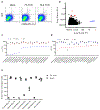T cell antigen discovery via signaling and antigen-presenting bifunctional receptors
- PMID: 30700902
- PMCID: PMC6755906
- DOI: 10.1038/s41592-018-0304-8
T cell antigen discovery via signaling and antigen-presenting bifunctional receptors
Abstract
CD8+ T cells recognize and eliminate tumors in an antigen-specific manner. Despite progress in characterizing the antitumor T cell repertoire and function, the identification of target antigens remains a challenge. Here we describe the use of chimeric receptors called signaling and antigen-presenting bifunctional receptors (SABRs) in a cell-based platform for T cell receptor (TCR) antigen discovery. SABRs present an extracellular complex comprising a peptide and major histocompatibility complex (MHC), and induce intracellular signaling via a TCR-like signal after binding with a cognate TCR. We devised a strategy for antigen discovery using SABR libraries to screen thousands of antigenic epitopes. We validated this platform by identifying the targets recognized by public TCRs of known specificities. Moreover, we extended this approach for personalized neoantigen discovery.
Conflict of interest statement
Competing Financial Interests Statements:
A.V.J., M.T.L., M.T.B., and D.B. are co-inventors on a patent application concerning the described technology. D.B. is a consultant of PACT and head of their scientific advising board. J.R.H. and A.R. are directors and consultants of PACT; M.T.B. and S.P are employees of PACT; J.M.Z. is a consultant of PACT; and each of the foregoing individuals have equity interests in PACT. The other authors declare that no competing interests exist.
Figures





References
-
- Leach DR, Krummel MF & Allison JP Enhancement of antitumor immunity by CTLA-4 blockade. Science 271, 1734–1736 (1996). - PubMed
-
- Yee C et al. Adoptive T cell therapy using antigen-specific CD8+ T cell clones for the treatment of patients with metastatic melanoma: in vivo persistence, migration, and antitumor effect of transferred T cells. Proceedings of the National Academy of Sciences of the United States of America 99, 16168–16173, doi:10.1073/pnas.242600099 (2002). - DOI - PMC - PubMed
Publication types
MeSH terms
Substances
Grants and funding
LinkOut - more resources
Full Text Sources
Other Literature Sources
Molecular Biology Databases
Research Materials

